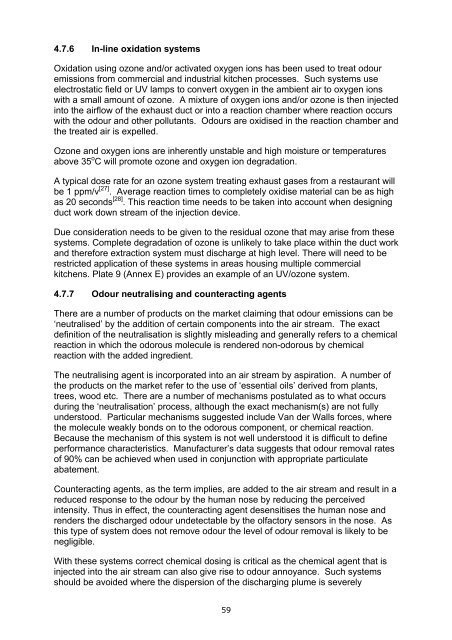Guidance on the Control of Odour and Noise from ... - Defra
Guidance on the Control of Odour and Noise from ... - Defra
Guidance on the Control of Odour and Noise from ... - Defra
Create successful ePaper yourself
Turn your PDF publications into a flip-book with our unique Google optimized e-Paper software.
4.7.6 In-line oxidati<strong>on</strong> systems<br />
Oxidati<strong>on</strong> using oz<strong>on</strong>e <strong>and</strong>/or activated oxygen i<strong>on</strong>s has been used to treat odour<br />
emissi<strong>on</strong>s <strong>from</strong> commercial <strong>and</strong> industrial kitchen processes. Such systems use<br />
electrostatic field or UV lamps to c<strong>on</strong>vert oxygen in <strong>the</strong> ambient air to oxygen i<strong>on</strong>s<br />
with a small amount <strong>of</strong> oz<strong>on</strong>e. A mixture <strong>of</strong> oxygen i<strong>on</strong>s <strong>and</strong>/or oz<strong>on</strong>e is <strong>the</strong>n injected<br />
into <strong>the</strong> airflow <strong>of</strong> <strong>the</strong> exhaust duct or into a reacti<strong>on</strong> chamber where reacti<strong>on</strong> occurs<br />
with <strong>the</strong> odour <strong>and</strong> o<strong>the</strong>r pollutants. <strong>Odour</strong>s are oxidised in <strong>the</strong> reacti<strong>on</strong> chamber <strong>and</strong><br />
<strong>the</strong> treated air is expelled.<br />
Oz<strong>on</strong>e <strong>and</strong> oxygen i<strong>on</strong>s are inherently unstable <strong>and</strong> high moisture or temperatures<br />
above 35 o C will promote oz<strong>on</strong>e <strong>and</strong> oxygen i<strong>on</strong> degradati<strong>on</strong>.<br />
A typical dose rate for an oz<strong>on</strong>e system treating exhaust gases <strong>from</strong> a restaurant will<br />
be 1 ppm/v [27] . Average reacti<strong>on</strong> times to completely oxidise material can be as high<br />
as 20 sec<strong>on</strong>ds [28] . This reacti<strong>on</strong> time needs to be taken into account when designing<br />
duct work down stream <strong>of</strong> <strong>the</strong> injecti<strong>on</strong> device.<br />
Due c<strong>on</strong>siderati<strong>on</strong> needs to be given to <strong>the</strong> residual oz<strong>on</strong>e that may arise <strong>from</strong> <strong>the</strong>se<br />
systems. Complete degradati<strong>on</strong> <strong>of</strong> oz<strong>on</strong>e is unlikely to take place within <strong>the</strong> duct work<br />
<strong>and</strong> <strong>the</strong>refore extracti<strong>on</strong> system must discharge at high level. There will need to be<br />
restricted applicati<strong>on</strong> <strong>of</strong> <strong>the</strong>se systems in areas housing multiple commercial<br />
kitchens. Plate 9 (Annex E) provides an example <strong>of</strong> an UV/oz<strong>on</strong>e system.<br />
4.7.7 <strong>Odour</strong> neutralising <strong>and</strong> counteracting agents<br />
There are a number <strong>of</strong> products <strong>on</strong> <strong>the</strong> market claiming that odour emissi<strong>on</strong>s can be<br />
‘neutralised’ by <strong>the</strong> additi<strong>on</strong> <strong>of</strong> certain comp<strong>on</strong>ents into <strong>the</strong> air stream. The exact<br />
definiti<strong>on</strong> <strong>of</strong> <strong>the</strong> neutralisati<strong>on</strong> is slightly misleading <strong>and</strong> generally refers to a chemical<br />
reacti<strong>on</strong> in which <strong>the</strong> odorous molecule is rendered n<strong>on</strong>-odorous by chemical<br />
reacti<strong>on</strong> with <strong>the</strong> added ingredient.<br />
The neutralising agent is incorporated into an air stream by aspirati<strong>on</strong>. A number <strong>of</strong><br />
<strong>the</strong> products <strong>on</strong> <strong>the</strong> market refer to <strong>the</strong> use <strong>of</strong> ‘essential oils’ derived <strong>from</strong> plants,<br />
trees, wood etc. There are a number <strong>of</strong> mechanisms postulated as to what occurs<br />
during <strong>the</strong> ‘neutralisati<strong>on</strong>’ process, although <strong>the</strong> exact mechanism(s) are not fully<br />
understood. Particular mechanisms suggested include Van der Walls forces, where<br />
<strong>the</strong> molecule weakly b<strong>on</strong>ds <strong>on</strong> to <strong>the</strong> odorous comp<strong>on</strong>ent, or chemical reacti<strong>on</strong>.<br />
Because <strong>the</strong> mechanism <strong>of</strong> this system is not well understood it is difficult to define<br />
performance characteristics. Manufacturer’s data suggests that odour removal rates<br />
<strong>of</strong> 90% can be achieved when used in c<strong>on</strong>juncti<strong>on</strong> with appropriate particulate<br />
abatement.<br />
Counteracting agents, as <strong>the</strong> term implies, are added to <strong>the</strong> air stream <strong>and</strong> result in a<br />
reduced resp<strong>on</strong>se to <strong>the</strong> odour by <strong>the</strong> human nose by reducing <strong>the</strong> perceived<br />
intensity. Thus in effect, <strong>the</strong> counteracting agent desensitises <strong>the</strong> human nose <strong>and</strong><br />
renders <strong>the</strong> discharged odour undetectable by <strong>the</strong> olfactory sensors in <strong>the</strong> nose. As<br />
this type <strong>of</strong> system does not remove odour <strong>the</strong> level <strong>of</strong> odour removal is likely to be<br />
negligible.<br />
With <strong>the</strong>se systems correct chemical dosing is critical as <strong>the</strong> chemical agent that is<br />
injected into <strong>the</strong> air stream can also give rise to odour annoyance. Such systems<br />
should be avoided where <strong>the</strong> dispersi<strong>on</strong> <strong>of</strong> <strong>the</strong> discharging plume is severely<br />
59
















